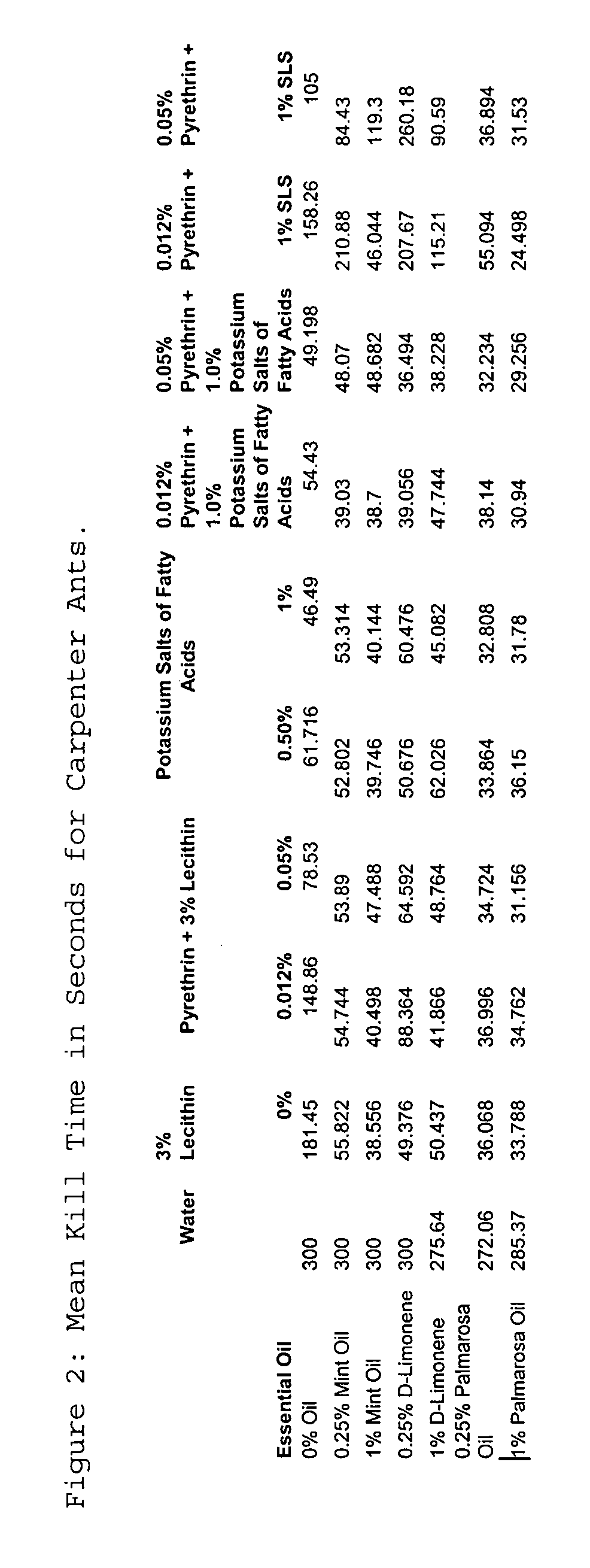Insecticidal compositions and methods of using same
a technology of insecticidal compositions and compositions, applied in the field of insecticidal compositions, can solve the problems of poor efficacy of insecticidal soap by itself, affecting the osmotic relationship of cellular osmotic cells, and disrupting the cellular osmotic relationship, so as to achieve the effect of poor efficacy and effective produ
- Summary
- Abstract
- Description
- Claims
- Application Information
AI Technical Summary
Benefits of technology
Problems solved by technology
Method used
Image
Examples
example 1
[0060] The following compositions were compared for effectiveness: a) the Victor® Poison Free Ant and Roach Killer formulation containing 4.0% mint oil as the sole active ingredient; b) Safer® brand Insect Killing Soap formulation providing a concentration of 2.0% potassium salts of fatty acids as the sole active ingredient; c) a formulation of 4.0% mint oil with 2.0% potassium salts of fatty acids; d) a formulation of 4.0% mint oil with 2.0% potassium salts of fatty acids and 3.0% lecithin; e) Victor® Poison Free Wasp & Hornet Killer formulation containing 8% mint oil with 1% SLS as the active ingredients; f) a formulation of 8% mint oil with 2% potassium salts of fatty acids; and g) a formulation of 8% mint oil with 2% potassium salts of fatty acids and 1% SLS. Previous experiments demonstrated that treatment of insects with 1% SLS alone did not kill insects within the 300 second time period used in testing (data not shown). All of the above formulations were tested using the Amer...
example 2
[0090] A study using the methodology of Example 1 was performed using German cockroaches (Blatella germanica). Treatments 1, 2, and 3 consisted of aerosolized test material using carbon dioxide as the propellant. Aerosol cans were filled at LHB Industries (St. Louis, Mo.) per Woodstream specification. Treatment 4 was formulated in the Woodstream laboratory, placed into a bottle, and dispensed using a hand pump trigger sprayer.
[0091] The experimental formulations were in the following percentages of the admixed components by weight:
Treatment 1: Victor® Poison Free Ant and Roach Insect Killer
[0092] 4.0% mint oil [0093] 5.0% mineral oil [0094] 3.0% lecithin [0095] 88.0% water
Treatment 2: 4.0% Mint Oil with 3.0% Lecithin and 2.0% Potassium Salts of Fatty Acids [0096] 4.00% mint oil [0097] 5.00% mineral oil [0098] 3.00% lecithin [0099] 4.04% Safer Brand Insect Killing Soap Concentrate [0100] 83.96% water
Treatment 3: 4.0% Mint Oil with 2.0% Potassium Salts of Fatty Acids [0101] 4....
example 3
[0107] A range of concentrations of pyrethrins from 0.01% to 0.5% by weight can be combined with 0.25% to 8% by weight of at least two essential oils such as mint and D-limonene or palmarosa oil and thyme oil. The formulation will include an anti-oxidant such as ethoxyquin, a tocopherol, or BHT to prevent the pyrethrins from breaking down. As pyrethrins are not readily water soluble, an alcohol may also be included, such as SD3A or SDA3C or other denatured alcohols in the composition to help solubilize the pyrethrins. Mineral oil or an equivalent substance can also be used at a concentration of about 5% by weight to allow the composition to remain on the surface for up to four weeks. The balance is water.
PUM
 Login to View More
Login to View More Abstract
Description
Claims
Application Information
 Login to View More
Login to View More - R&D
- Intellectual Property
- Life Sciences
- Materials
- Tech Scout
- Unparalleled Data Quality
- Higher Quality Content
- 60% Fewer Hallucinations
Browse by: Latest US Patents, China's latest patents, Technical Efficacy Thesaurus, Application Domain, Technology Topic, Popular Technical Reports.
© 2025 PatSnap. All rights reserved.Legal|Privacy policy|Modern Slavery Act Transparency Statement|Sitemap|About US| Contact US: help@patsnap.com



